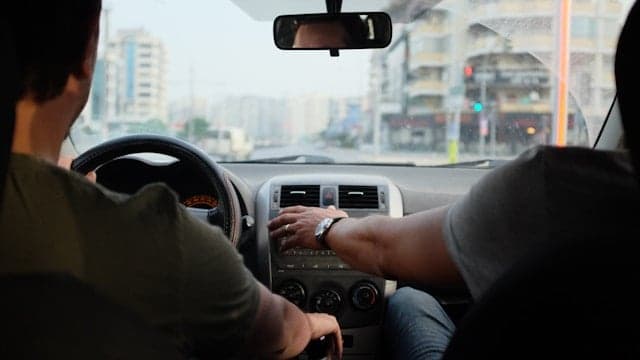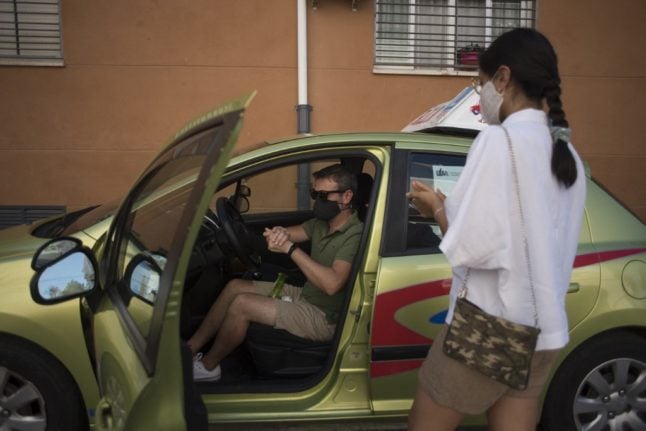Spanish driving licence: the essential language to pass your practical test

Understanding what your driving instructor is saying to you in Spanish will be crucial if you want to pass your practical test.
Getting a driving licence in Spain (sacarse el carné de conducir en España) can be a fairly challenging task for foreigners.
There’s having to memorise Spain’s specific road laws, the big difference in prices between driving schools depending on where you are and, last but not least, understanding Spain’s driving lingo.
Although Spain’s Directorate General for Traffic (DGT) does offer the possibility of taking your theory exam in English, French and German, the practical driving exam has to be carried out in Spanish.
There are some specialised driving schools (autoescuelas in Spanish) that have instructors who can offer practical lessons in English, but when it comes to actually sitting at the wheel with the DGT examiner in the back seat, it’s almost certainly all going to be in Spanish.
With this in mind, we’re going to revise the most common instructions that you’re likely to receive from your driving instructor while you’re practising driving, and during your final examen práctico with the examiner.
To keep it as real as possible, all the Spanish verbs we’ll use will be in the imperative form, as that’s what you’re most likely to hear from your instructor.
We’ve mixed up these with the useful vocab you’re likely to hear to put it all in context, so pay special attention to each part of the sentence.
The basics
Acelera : Speed up
Frena : Brake
Reduce la velocidad : Reduce your speed
Detente/Para : Stop
Pisa el embrague : Step on the clutch
Important extras
Ponte el cinturón (de seguridad) : Put on your seatbelt
Asegúrate que tienes bien colocados los retrovisores : Make sure your rearview mirrors are correctly positioned

Getting going
Arranca el coche : turn on the car
Pon las luces cortas/largas : Put on your headlights/brights
Pon el intermitente : Put on your indicator
Gira el volante a la izquierda/derecha : Turn the steering wheel to the left/right
El semáforo está en verde/en rojo/en ámbar : The traffic light is green, red, yellow
Gears
Mete primera, segunda, tercera, cuarta, quinta marcha : Go into first, second, third, fourth, fifth gear
Mete la palanca de cambio en punto muerto : Put the gearbox in neutral
Parking
Da marcha atrás : Reverse
Pon las luces de emergencia : Put on your emergency lights
Aparca en batería, en línea o en paralelo : Park at an angle, in line, parallel park
Pon/Quita el freno de mano : Pull up/down the handbrake
Turning and moving around
Circula por esta carretera de sentido único : Drive along this one-way road
Cede el paso : Give way
Adelanta a la furgoneta : Overtake the van
Incorpórate a la autopista/la rotonda : Merge onto the motorway/roundabout
Acuérdate que es una carretera de sentido único/dos sentidos : Remember it’s a one-way/two-way road
Toma la primera/segunda/tercera salida : Take the first/second/third exit
Échale un vistazo al punto ciego : Check your blind spot
Mira por el retrovisor : Look through the rearview mirror
Cambia de carril : Change lane
Métete por el carril de dentro/fuera : Take the inside/outside lane
Toma la siguiente salida : Take the next exit
Precautions
No superes el límite de velocidad : Don’t go over the speed limit
Ten cuidado con la curva : Be careful with the turn
Deja pasar al peatón en el paso de cebra : Let the pedestrian cross at the zebra crossing
Asegúrate que no vienen coches en el cruce : Make sure there’s no oncoming traffic at the crossing
And a couple of extra ones
Toca el claxon/la bocina : Honk your horn
Pon el limpiaparabrisas : Put on the windshield wipers
READ MORE
Comments
See Also
Getting a driving licence in Spain (sacarse el carné de conducir en España) can be a fairly challenging task for foreigners.
There’s having to memorise Spain’s specific road laws, the big difference in prices between driving schools depending on where you are and, last but not least, understanding Spain’s driving lingo.
Although Spain’s Directorate General for Traffic (DGT) does offer the possibility of taking your theory exam in English, French and German, the practical driving exam has to be carried out in Spanish.
There are some specialised driving schools (autoescuelas in Spanish) that have instructors who can offer practical lessons in English, but when it comes to actually sitting at the wheel with the DGT examiner in the back seat, it’s almost certainly all going to be in Spanish.
With this in mind, we’re going to revise the most common instructions that you’re likely to receive from your driving instructor while you’re practising driving, and during your final examen práctico with the examiner.
To keep it as real as possible, all the Spanish verbs we’ll use will be in the imperative form, as that’s what you’re most likely to hear from your instructor.
We’ve mixed up these with the useful vocab you’re likely to hear to put it all in context, so pay special attention to each part of the sentence.
The basics
Acelera : Speed up
Frena : Brake
Reduce la velocidad : Reduce your speed
Detente/Para : Stop
Pisa el embrague : Step on the clutch
Important extras
Ponte el cinturón (de seguridad) : Put on your seatbelt
Asegúrate que tienes bien colocados los retrovisores : Make sure your rearview mirrors are correctly positioned

Getting going
Arranca el coche : turn on the car
Pon las luces cortas/largas : Put on your headlights/brights
Pon el intermitente : Put on your indicator
Gira el volante a la izquierda/derecha : Turn the steering wheel to the left/right
El semáforo está en verde/en rojo/en ámbar : The traffic light is green, red, yellow
Gears
Mete primera, segunda, tercera, cuarta, quinta marcha : Go into first, second, third, fourth, fifth gear
Mete la palanca de cambio en punto muerto : Put the gearbox in neutral
Parking
Da marcha atrás : Reverse
Pon las luces de emergencia : Put on your emergency lights
Aparca en batería, en línea o en paralelo : Park at an angle, in line, parallel park
Pon/Quita el freno de mano : Pull up/down the handbrake
Turning and moving around
Circula por esta carretera de sentido único : Drive along this one-way road
Cede el paso : Give way
Adelanta a la furgoneta : Overtake the van
Incorpórate a la autopista/la rotonda : Merge onto the motorway/roundabout
Acuérdate que es una carretera de sentido único/dos sentidos : Remember it’s a one-way/two-way road
Toma la primera/segunda/tercera salida : Take the first/second/third exit
Échale un vistazo al punto ciego : Check your blind spot
Mira por el retrovisor : Look through the rearview mirror
Cambia de carril : Change lane
Métete por el carril de dentro/fuera : Take the inside/outside lane
Toma la siguiente salida : Take the next exit
Precautions
No superes el límite de velocidad : Don’t go over the speed limit
Ten cuidado con la curva : Be careful with the turn
Deja pasar al peatón en el paso de cebra : Let the pedestrian cross at the zebra crossing
Asegúrate que no vienen coches en el cruce : Make sure there’s no oncoming traffic at the crossing
And a couple of extra ones
Toca el claxon/la bocina : Honk your horn
Pon el limpiaparabrisas : Put on the windshield wipers
READ MORE
Join the conversation in our comments section below. Share your own views and experience and if you have a question or suggestion for our journalists then email us at [email protected].
Please keep comments civil, constructive and on topic – and make sure to read our terms of use before getting involved.
Please log in here to leave a comment.